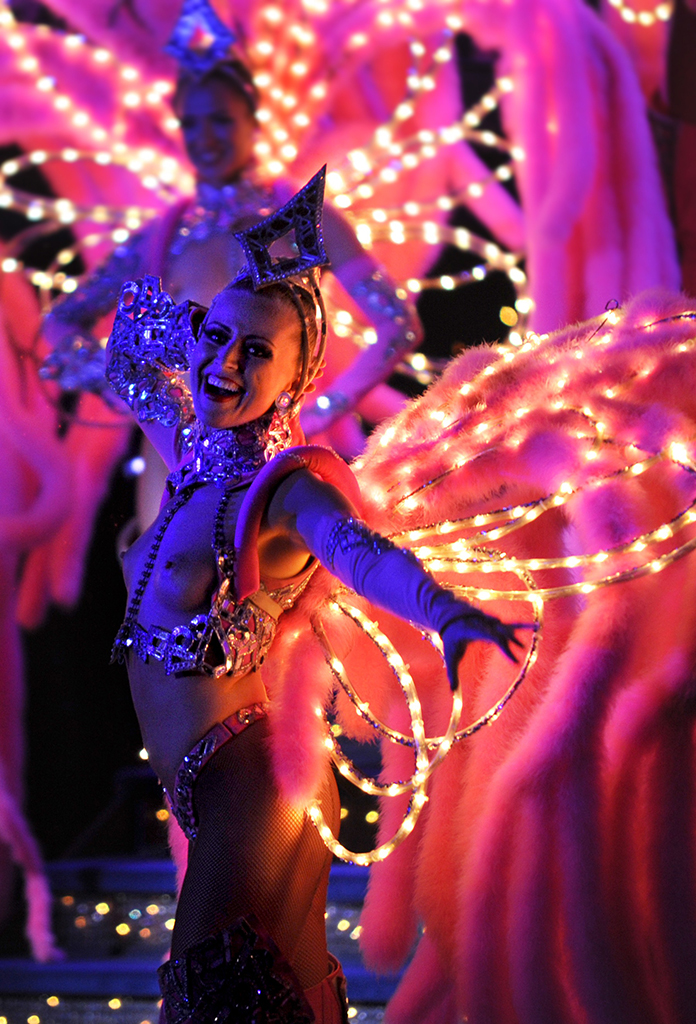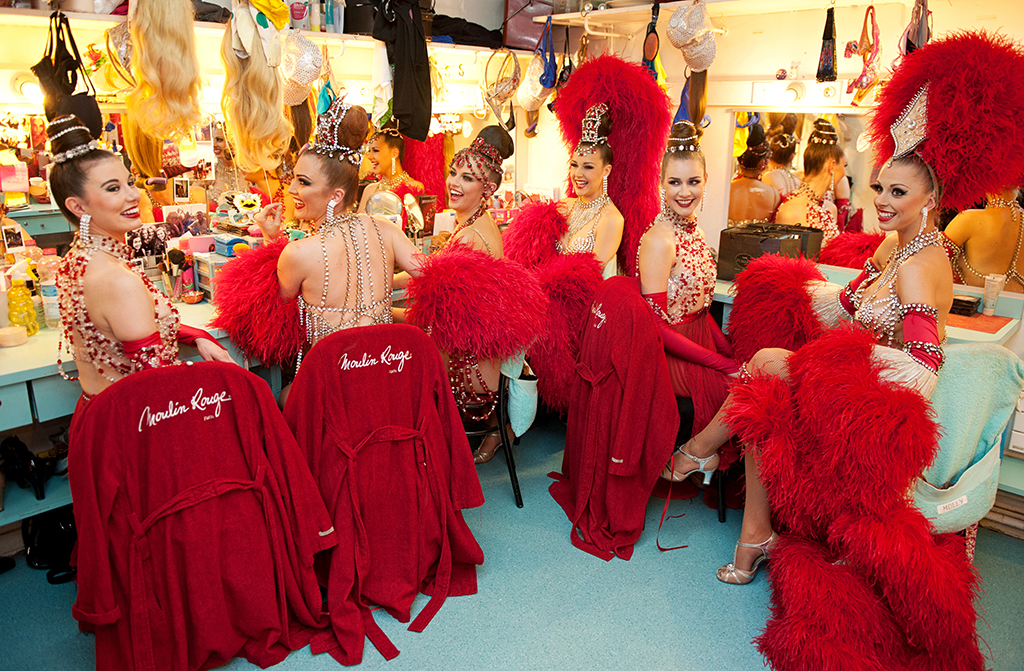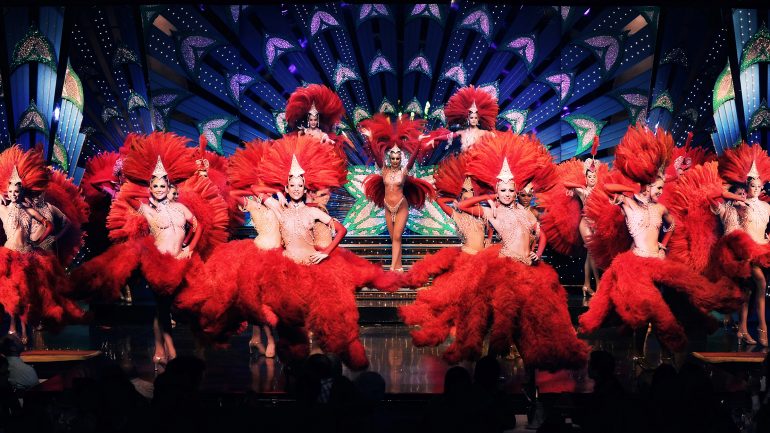October 6, 1889. The Belle Epoque is in full swing. The upper classes let their hair down in the music-halls and cabarets with the dancing girls. This was the carefree context in which Oller and Zidler created the Moulin Rouge.
It was presented as the “First Palace of Dance and Women” and included the mythical French cancan, a huge dance floor and many beautiful dancers.
127 years later, this is exactly what it has become. The Moulin Rouge is the most celebrated cabaret in the world and each year millions of spectators come to feast their eyes on the famous revues.
“In 2014, an English-based agency ranked the Moulin Rouge 4th among the most photographed monuments in the world”, explains Jean-Luc Pehau-Ricau, Communication and Marketing Director.
Féérie at the Moulin Rouge
4 scenes, 100 artists, including 6O Doriss Girls recruited from around the world, 1 aquarium holding 40 tons of water, 6 miniature horses, 5 pythons, 1,000 feather costumes, sparkle and sequins, 800 pairs of shoes, 80 musicians, 60 chorists… the magical Féérie needs what it takes!
Dancing stars
The stars of an evening at the Moulin Rouge are the not-to-be-missed Doriss Girls and Doriss Dancers who come from all four corners of the world, led by the dream of performing one day in the world’s largest ever cabaret. “I always dreamed of entering the Moulin. I passed an audition in Australia and was selected. I couldn’t believe it. I was 20 when I got to Paris. And my dream came true”, explains Amanda, an Australian dancer.

Copyright photos : Le Moulin Rouge
The selection process is however fairly drastic. Training in classical dance is a must, as is a height of at least 1.75m for the female dancers and 1.85m for the men, a perfect physique … it’s worth it! And for those lucky enough to be selected, this is only the beginning. To be a dancer at the Moulin Rouge requires a super healthy lifestyle. The rehearsals last 5 hours per day with 2 days devoted entirely to the French cancan. Weight loss is strictly controlled. Haircuts are monitored. Dangerous sporting activities are forbidden. But all in all, not much compared to the satisfaction got from dazzling the crowds each night. “The stage is like a drug. We all dread the day we will have to leave the Moulin Rouge and particularly the public.” Says Sophie who has been performing at the Moulin Rouge for 10 years now.
Although the Doriss Girls and Doriss Dancers are undoubtedly the stars of the show, nothing would be possible without the experts backstage: costume designers, dressers, musicians, machinists, leaders … over 400 people who work backstage every day to make the magic happen.
My feathery thing
Excellence being the key word, the Moulin Rouge needed a great name to provide the Moulin’s emblematic accessory, feathers. Since 1929, the famous Maison Février has been the cabaret’s official supplier, and also supplied Joséphine Baker, Line Renaud, Zizi Jeanmaire, Dita Von Tesse etc. Just some of the outstanding artistic projects that have made it the world’s leading feather worker.
In 2014, an English-based agency ranked the Moulin Rouge 4th among the most photographed monuments in the world.
Ostrich, pheasant, cock, goose, heron… so many origins, colors and feather types. Nothing synthetic, all the feathers are unique and each creation comes with its very own veterinary certificate.
Who is the most beautiful of them all
Sequins, glitter, pearls, embroidery, satin… the costumes are an integral part of the show’s magic. Designed by Corrado Colabucci, each outfit is entirely handmade and requires anywhere between 10 and 280 hours to make. In all, “Féérie” is 1,000 costumes for a total cost of 4 million Euros. And although the aim of the costumes is to showcase the full beauty of the Doriss Girls, they also need to be light and easy to wear so as not to hinder their movements.

Sexy right down to their toes
To round it all off come the shoes! Since 1945, the prestigious Maison Clairvoy has been creating, manufacturing and selling its made-to-measure shoes to the world of showbiz, and also specializes in the creation of the famous French cancan ankle boots.
Five boot specialists personalize and imagine the 800 pairs needed for the show using only the best leathers from around the world. Calf, goat, box calf, lamb… the skins should be supple, hard-wearing and comfortable for the dancers to wear when performing.
During the show, between each scene, another ballet begins backstage with the ever active seamstresses who help the 60 dancers change between scenes. It’s all a question of timing and organization, each costume is labeled, each dancer has her dresser to help her change in a record time. A pearl falls? No panic, the seamstresses are also there to repair without wasting a second. Like a colony of ants with only one goal in mind: excellence. “We can always count on them. They constantly pamper us and look after us to ensure everything happens without a hitch” explains Sophie.
Entertaining the tastebuds
Back to the show and the sumptuous Belle Epoque room created by Henri Mahé in 1951. As the dancers warm up, the catering team get the tables ready. Head waiters, cooks, waiters… make up France’s largest kitchen brigade: 120 professionals from the best catering schools in France prepare the 900 place settings as if working to music.
In the kitchens 25 cooks prepare the three menus on offer under the guidance of Chef David Le Quellec, a big name in the world of food.

7 pm. The doors open and the clients take their seats to enjoy a selection of refined dishes and taste some of France’s finest wines. And for that perfect magical evening, the champagne corks will be popping all night long. The 240,000 bottles opened each year make the Moulin Rouge the largest you know what!
9 pm. The tables have been cleared. The show can begin …
The Moulin Rouge is not a story, it simply is. Lights!
LE MOULIN ROUGE
82 Boulevard de Clichy
75018 Paris, France
+33 (0)1 53 09 82 82
www.moulinrouge.fr


